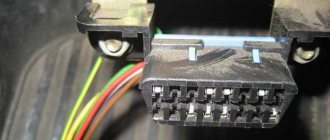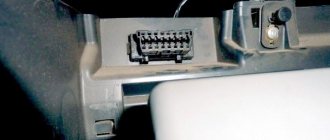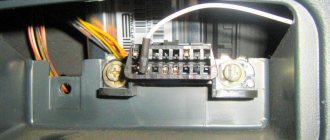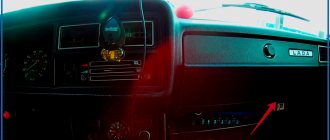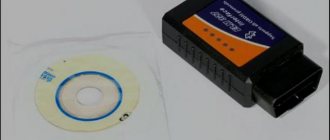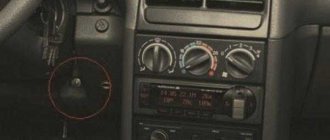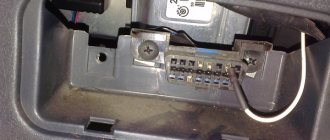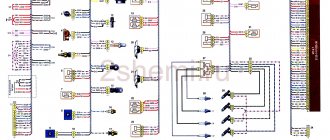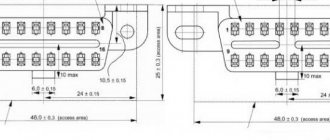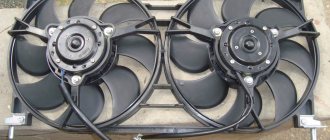| Probable Cause | ||
| Code 11 (one long flash, one short flash) | Crankshaft angle sensor or circuit | No reason |
| Code 12 (one long flash, two short flashes) | Starter switch | The starter switch remains constantly on or off |
| Code 13 (one long flash, three short flashes) | Camshaft Angle Sensor | No reason |
| Code 14 (one long flash, four short flashes). | Fuel injector 1 | Poor fuel injector operation |
| Code 15 (one long flash, five short flashes). | Fuel injector 2 | Poor fuel injector operation |
| Code 16 (one long flash, six short flashes) | Fuel injector 3 | Poor fuel injector operation |
| Code 17 (one long flash, seven short flashes) | Fuel injector 4 | Poor fuel injector operation |
| Code 21 (two long flashes, one short flash) | Coolant temperature sensor | The sensor or sensor circuit is malfunctioning |
| Code 22 (two long flashes, two short flashes) | Knock sensor | The electrical circuit of the sensor is broken or shorted |
| Code 23 (two long flashes, three short flashes) | Air flow sensor | The electrical circuit of the sensor is broken or shorted |
| Code 24 (two long flashes, four short flashes) | Air control valve | Valve electrical circuit is open or shorted |
| Code 31 (three long flashes, one short flash) | Throttle position sensor | The electrical circuit of the sensor is broken or shorted |
| Code 32 (three long flashes, two short flashes) | Oxygen sensor | The electrical circuit of the oxygen sensor is broken |
| Code 33 (three long flashes, three short flashes) | Vehicle speed sensor | There is no signal from the vehicle speed sensor |
| Code 35 (three long flashes, five short flashes) | Cleaning solenoid valve | Purge solenoid valve always on or always off |
| Code 41 (four long flashes, one short flash) | Fuel mixture composition | Not optimal fuel mixture ratio |
| Code 42 (four long flashes, two short flashes) | Switching signal | Incorrect switching signal |
| Code 44 (four long flashes, four short flashes) | Damper actuator | Damper actuator valve faulty |
| Code 45 (four long flashes, five short flashes) | Atmospheric sensor | The atmospheric sensor is faulty |
| Code 49 (four long flashes, nine short flashes) | Air flow sensor | Air flow sensor faulty |
| Code 51 (five long flashes, one short flash). | Neutral switch | Neutral switch remains in permanently on position |
| Code 51 (five long flashes, one short flash) | Starter blocker | The lock switch remains in the on position at all times |
| Code 52 (five long flashes, two short flashes) | Position switch | The parking switch remains in the always on position |
| To determine fault codes in the obd2 self-diagnosis system, you must connect the scanner to the 16-pin diagnostic connector. |
Fault codes in the obd2 self-diagnosis system consist of five digits.
obd2 self diagnostic system fault codes
Diagnostic connector pins for used protocols
The OBDII standard allows for the use of 5 diagnostic protocols. Chevrolet Niva uses 3 of them:
- J1850 PWM. High-speed protocol with a performance of 41.6 Kb/sec. Transmits signals via pins 2, 4, 5, 10, 16.
- J1850 VPW. (The principle) of transmitting signals via pins 2, 4, 5, 16 is the same, but the speed is 10.4 Mb/s.
- ISO 9141-2. The simplest protocol that does not require complex communication microprocesses (unlike the above). Performs pulse transmission using pins 4, 5, 7, 15, 16
Features: The ISO 9141-2 protocol is easy to determine, thanks to pin 7, as well as the exclusion of pin 2 (10) on the Chevy Niva diagnostic connector.
If the system does not have pin 7, the SAE J1850 VPW (Variable Pulse Width Modulation or Pulse Width Modulation) protocol is used. The specified signal transmission protocols function properly via a standard OBD-II J1962 connector cable.
Selecting equipment for diagnosing Niva Chevrolet
The first step when choosing a cable for reading information from an on-board computer is determining the type of connector.
The main difference between OBDI and OBDII (besides the year of manufacture of the vehicle in which it is installed) is the shape of the connector. How to determine what type of pinout is used in a particular car is described in detail above. It is also possible to connect the K-Line connector to the OBD connector on the Niva Chevrolet. In this way, special diagnostic equipment is installed.
To read information from the OCU you will need:
- a scanning device that supports the required type of connections (currently, in addition to traditional equipment operating via a USB cable, there are items that support wi-fi and bluetooth functions);
- laptop;
- adapter (if necessary);
- appropriate software for diagnostics (for the Russian automotive industry, the ScanMaster ELM 2.1 and OpenDiagPro programs are recommended).
Important! The computer must support the same types of information transfer as the adapter. Otherwise, connection will not be possible.
There is a wide range of diagnostic equipment on the modern market. It is divided into the following types:
- "amateur" equipment;
- multi-brand (multifunctional) devices;
- professional equipment.
The last two categories are used for work at service stations and dealerships. For self-diagnosis, it is enough to purchase a simple adapter for beginners based on the ELM327 chip.
Even the most minimally functional equipment is capable of performing all basic tasks (detecting an error, correcting it, transmitting information about the state of the ECU to the PC screen). Such a service in service centers costs up to 1,500 rubles. Purchasing an adapter will save the Niva owner from the need to contact specialists and save money.
Carefully! There are cases when the controller generates an error even though it is fully operational. The reason is the failure of the scanning device itself.
Self-diagnosis
The function involves shutting down the system in which the breakdown occurred, followed by enabling a bypass program. A "Check Engine" light on the dashboard should worry the owner of a Chevrolet Niva. The developers have provided a standard self-diagnosis function. This option is useful in cases where there is a short-term failure in the program, but the machine continues to operate as normal. You can identify an “accident” using self-diagnosis.
ELM327 Niva, specifics
Bluetooth adapters ELM327 When I became concerned about this problem, I attracted an electronics engineer friend of mine, who is very, very meticulous in his profession. He immediately told me the following phrase: China and China are different. I have already tried to convey this idea to the people in an article about rear brake pads. On the current issue, we ordered several samples directly from the FACTORIES and began to slowly mock them, open them and break them. I won't wait long. Only ONE adapter connected normally with the fields and shnives. In the photo, he is in the middle. The rest either did not communicate with the smartphone or did not connect to power at all. Even my branded Konnwey adapter (far right), which sees almost the entire Japanese fleet and half of Europe, did not want to communicate with the fields.
Attention. The main and main function of this Bluetooth adapter ELM327 Niva is only one - to view and erase errors and turn off the “check engine on the panel” light. You can't do anything else on a wireless device. If you want to make friends with the engine more seriously, the tool must be different. A wired USB adapter (possibly with the same ELM327 chip) and a laptop with more serious diagnostic programs.
VAZ-21214 car. Reading codes
A – contact connected to ground;
B – diagnostic contact for sending a signal to the controller; G – electric fuel pump control contact; M – information output contact (serial data channel) The diagnostic block is used for communication with the controller. It is located under the glove compartment on the right side next to the controller.
Fault codes stored in the controller's memory can be read either with a special diagnostic tool or by counting the number of flashes of the "CHECK ENGINE" lamp.
Issuance of code 12 by the “CHECK ENGINE” indicator lamp
To read the codes with a lamp, you must connect contact “B” of the diagnostic block to ground. The easiest way is to short it to ground by connecting it to contact “A”, which is connected to engine ground.
When contacts “A” and “B” are connected to each other, the key in the ignition switch must be turned to position III (Ignition), but the engine should not run.
Under these conditions, the “CHECK ENGINE” lamp should flash code 12 three times in a row. This should happen in this order: flash, pause (1-2 s), flash, flash - long pause (2-3 s), and so on twice.
Code 12 indicates that the controller diagnostic system is working. If code 12 is not displayed, then there is a problem with the diagnostic system itself.
After code 12 is displayed, the CHECK ENGINE lamp displays fault codes three times, if they exist, or simply continues to display code 12 if there are no fault codes. If more than one fault code is stored in the controller’s memory, they are displayed 3 times each.
Warning Upon completion of the diagnostics, it is allowed to open contacts “A” and “B” of the diagnostic block 15 seconds after turning off the ignition.
Realities
Let's look at the ELM adapter from a purely technical perspective. Its function is simple - it is a translator between the car's ECU and your smartphone or tablet. But translators are different, I declare this responsibly, as a person who speaks German. There are general translators, there is a technical language, there is a diplomatic language, and there is the pinnacle of the art of translation - simultaneous translation. The Chinese wireless version of the ELM adapter represents a high school student who got a C in English and thinks that he knows the language. It would be appropriate to recall an anecdote on this topic. *The Georgian went swimming and began to drown. I either didn’t know the word “help” or forgot it. A man is walking along the shore. The Georgian shouts: uh, darling, help, I’m swimming for the last time. * This is approximately the same information provided by the vast majority of Chinese “Elms”. The Chinese are deceiving consumers twice. First point: a real original ELM 327 chip costs about $20. This doesn't look like 400 rubles. The second point is that all electronics that end up on Ali and other similar sites are shamelessly cut down to cost 400 rubles, or even better, 300, or even better, even cheaper.
Chevrolet specialized service
The DDCAR service station has everything necessary to carry out high-quality diagnostics of various types of Chevrolet Lacetti. We perform diagnostics:
- comprehensive or complete, including a detailed check of all systems using computer testers, as well as a visual inspection;
- pre-sale, which allows you to identify obvious defects in the functionality of the car and bring it into proper shape before sale;
- computer, troubleshooting problems with the on-board computer and ECU.
ELM327 Niva, specifics
Bluetooth adapters ELM327
When I became concerned about this problem, I attracted an electronics engineer friend of mine, who is very, very meticulous in his profession. He immediately told me the following phrase: China and China are different. I have already tried to convey this idea to the people in an article about rear brake pads. On the current issue, we ordered several samples directly from the FACTORIES and began to slowly mock them, open them and break them. I won't wait long. Only ONE adapter connected normally with the fields and shnives. In the photo, he is in the middle. The rest either did not communicate with the smartphone or did not connect to power at all. Even my branded Konnwey adapter (far right), which sees almost the entire Japanese fleet and half of Europe, did not want to communicate with the fields.
Attention. The main and main function of this Bluetooth adapter ELM327 Niva is only one - to view and erase errors and turn off the “check engine on the panel” light. You can't do anything else on a wireless device. If you want to make friends with the engine more seriously, the tool must be different. A wired USB adapter (possibly with the same ELM327 chip) and a laptop with more serious diagnostic programs.
Reading time
Difficulty of the material:
For the pros - 4 out of 5
The ELM327 diagnostic adapter is widely popular among motorists. It allows you to carry out a quick computer service of electronic modules and track the values of important parameters of the internal combustion engine in real time. The adapter is easy to use and does not require special skills from the owner. The device is actively used for diagnosing not only foreign brands, but also domestic cars.
The ease of working with ELM327 is obvious - just connect the device to the service connector and synchronize it with your computer. The information will be displayed on the display of your PC or smartphone.
In this article you will learn:
Important:
Older models may be equipped with an OBD2 connector, but do not support available ISOs. Such blocks are diagnosed using separate tools.
Chevrolet Lacetti radio connector pinout - Chevrolet Without brakes
Connecting buttons on the Lacetti steering wheel to an Android radio
You can grind it down, but the metal is very soft, it’s better to cut it off. Those who use navigators under Win-CE can read this topic: pinout of Chevrolet Lacetti radio connectors, but judging by the activity of posts in the topics, when diagnosing the Lacetti, most people use a combination of a Laptop tablet or a desktop PC running Windows OS, a KKL-Line VAG COM adapter Download The latest version of the program, as well as how to make it yourself and where to buy an adapter that works with it, can be found here. In the future, do not forget to thank the developers.
Chevrolet Lacetti SW SW › Logbook › Replacement radio. part 2. Power connection. The colors match...
We move the front panel to the side for now. I replaced some of the clips; they deteriorate during installation and removal, and before that I removed the clips in general to make it easier to try on the depth of the radio when installing.
The powerful car quickly conquered the market in this segment. Solder the wires from the remaining switch contacts to pins 12 and 13 of the adapter. This is quite noticeable in the photo.
We carefully bend the antenna so that it can fix the contact in the new connector.
And insert the contact into the ISO power connector on the radio adapter. This is quite noticeable in the photo.
We rivet a crimp connector at the end of the wire and join the orange wires - ours just made and the one that comes from the radio connector - it ends with the white part of the connector with a transparent vinyl tip - we connect tightly. We also connect the yellow and red wires of the radio adapter, as shown in the photo.
Simply put, we don’t confuse colors, but combine them as in the photo. Work on the radio adapter is completed. Next, we make two wires according to the same principle as we did the orange one - the color of the wires does not matter, I spoiled several when I did it - in the end we should get 2 wires. We crimp connectors at the ends of the leads, and different ones - a socket and a plug.
You can cut it with metal scissors. You can grind it down, but the metal is very soft, it’s better to cut it off. The photo is not very clear, but it is clear that the contact has been cut and has become narrower.
Next, take the frame for the radio in your hands. We need to bore, for example, longitudinal holes with a round file towards the front of the frame for the fastening screws so that the head of the radio sticks out from the frame as shown in the photo.
You can clearly see from above what the top part of the radio looks like and how to secure the radio in the frame. Having drilled and tried on the radio, we plug the adapter radio - ISO connectors into the radio. We put the radio into the frame, carefully remove all the wires from the back side and fasten it with the supplied screws. Please note - first the adapter, then the mount.
Compatibility of VAZ cars with ELM327
The OBD 2 standard, according to which the adapter operates, supports the service of all cars with an electronic injection control system. There are some differences in diagnosing certain types of ECUs, but the general maintenance methods remain the same.
In this section, the user can find accurate information about the compatibility of the ELM327 with the desired vehicle. The table lists the years of production, as well as models. Just select your VAZ type in the list and the system will automatically provide all the information on computer servicing.
Chevrolet Cruze ECU pinout
To flash the ECU firmware, you need to connect the programmer to the terminals and know the pinout of the block contacts. The article “Do-it-yourself computer diagnostics of the Chevrolet Cruze” contains information about the firmware methods and types of ECUs that were equipped with Chevy Cruze engines, depending on the year of manufacture.
For example, check out the pinout of the Delphi MT-80 ECU. For other units (Simtec76, Sirius D42, GM Delco E83), the pinout can be viewed using Combiloader - this is a program for downloading firmware.
Contact assignment:
Diagnostic modes, OBD protocols for VAZ cars
The OBD standard has five types of information exchange protocols:
- CAN type;
- KWP2000;
- ISO 9141 version 2;
- J1850 VPW and PWM.
The purpose of OBD is to harmonize the various electronic systems of the car and ensure the exchange of information between devices. The standard establishes a number of rules for the transmission of data packets. The exchange speed is individual for each protocol. The ELM327 adapter coordinates the ECU and external devices for reading information. The data is displayed to the user in an accessible form.
The fastest is the CAN bus. The latest Zhiguli models provide for the use of this standard. Other protocols on this family:
- ISO 9141;
- K, L lines;
- K, L lines (extended block 55 pins).
Note: the number of supported diagnostic and interrogation modes of on-board systems depends on the installed protocol. The owner needs to check the year of manufacture and model of the standard control unit before servicing. The more recent the ECU and its firmware, the wider the list of available scanning parameters.
Important:
Some ECUs do not support the full set of functions without the use of a dealer scanner.
Select the car model and year of manufacture to determine which diagnostic modes your car supports through the ELM327 adapter, as well as what protocol the OBD2 port is based on. The data is presented for the following VAZ models and their modifications: 2114, 2107, 2110, 2112, 2109, 2115, 2106, 2108 and others.
Note:
(1) — The numbers between brackets (x3) correspond to the number of vehicles of the same type
(2) - DIN horsepower (multiplied by 0.736 for kW power)
(3) - PID is only supported for the primary oxygen sensor (#1)
- Mode X Column: A vehicle showing 00000000 in a mode means that the corresponding PID is not active and that as a result the mode is maintained but does not respond to any requests. None of the vehicles described below support Mode 8.
- Energy column: fuel type, Die for diesel, Pet for gasoline, Hyb for hybrid
- The vehicles on this list are classified alphabetically by make, model, then in order of increasing horsepower.
Mode 1
This mode returns common values for some sensors, such as:
- engine speed;
- vehicle speed;
- engine temperature (air, coolant);
- information about oxygen sensors and air-fuel mixture.
Mode 2
This mode provides a freeze frame (or instantaneous) failure data. When the ECM detects a malfunction, it records sensor data at the specific point in time when the malfunction occurs.
Mode 3
This mode displays stored diagnostic trouble codes. These fault codes are standard for all car brands and are divided into 4 categories:
P0xxx: for standard transmission related faults (engine and transmission) C0xxx: for standard chassis faults B0xxx: for standard body faults U0xxx: for standard communication network faults
More detailed information and definitions of common trouble codes are available on the OBD Common Trouble Codes page.
Mode 4
This mode is used to clear stored trouble codes and turn off the engine malfunction indicator.
Note: There is generally no need to repair a problem that has not been diagnosed or corrected. The MIL will illuminate again during the next driving cycle.
Mode 5
This mode provides the results of self-diagnosis performed on the oxygen/lamda sensors. This mainly applies only to gasoline vehicles. For new ECUs using CAN, this mode is no longer used. Mode 6 replaces features that were available in Mode 5.
Mode 6
This mode provides self-diagnosis results performed on systems that are not subject to constant monitoring.
Mode 7
This mode produces unconfirmed fault codes. After repair, it is very useful to check that the fault code does not appear again, without having to perform a lengthy test run. The codes used are identical to those in mode 3.
Mode 8
This mode provides self-diagnosis results on other systems. It is unlikely to be used in Europe.
Mode 9
This mode gives vehicle information such as:
- VIN (vehicle identification number)
- calibration values
Mode 10 (or Mode A)
This mode gives permanent error codes. The codes used are identical to those in modes 3 and 7. Unlike modes 3 and 7, these codes cannot be cleared using mode 4. Only a few road cycles without the problem occurring can clear the fault.
Which program is suitable for elm327 obd2 scanner on an Android smartphone?
Quite a difficult question for a beginner. There are many programs in the play market; the developer of my scanner, for example, strongly suggests Torque . The program is beautifully done. For cars of the desired brand, you can additionally download so-called PID files (a set of sensors) and make settings for them. I did not find a PID for my car.
I didn’t like Torque as an on-board computer; it diagnoses errors, but I didn’t understand the settings. It seems to me that it is poorly compatible with domestic cars.
I recommend two other programs. One for diagnostics only, called OpenDiag . It will show errors, knows how to reset them, and also knows how to reset the ECU to factory settings. If you configure it correctly, there is no price for it!
I use a different one for the on-board computer. There is a normal Russian language, the instrument panel is already configured, it has what I need. Even the free functionality is enough to display the readings of any sensor in the form of a graph and set the boundaries of optimal and threshold values. You can look by dates at what happened before and what is now. Very easy to use and set up for a newbie like me. It's called Car Scanner .
The functionality of these programs is approximately the same, but compatibility with your car and user friendliness are of great importance. These applications are easy to download to your smartphone; there are also versions for Windows (Open Diag).
Is my ELM working well? Yes, I'm happy. With the help of a friend, we carried out diagnostics for the first time since purchasing the car. Mileage 40,000. Showed mismatch of camshaft and crankshaft marks, incorrect opening angle of the air damper. Increased air mass flow, increased fuel consumption.
I removed and washed the housing with the damper in kerosene. I removed the cylinder head cover and it turned out that the chain guide had been completely chewed up and the chain was dangling. I aligned the marks, installed a new damper and chain tensioner. I pulled the chain. Replaced the fuel filter. After which the scanner no longer showed errors.
Where is the diagnostic connector located on a Chevrolet Niva?
The classic location of the diagnostic connector block in most cars is behind the steering wheel near the ignition switch. Chevy Niva is no exception. The OBD type pinout is used. On-board diagnostics of the first generation was developed back in 1991 with the purpose of reading information on the state of the ECU (electronic control unit). This system is responsible for all engine functions.
The first copies of Niva Chevrolet used a 12-pin OBD1 connector. Since 2002, it was changed to 16-pin OBD2. To select the correct diagnostic equipment for the on-board computer, you need to find out in advance what type of pinout is in a particular Chevrolet Niva.
Additional Information
On some Chevrolet Niva models there is a 12-pin block, this is due to the fact that these models are equipped with other control units of older models. Modern car scanners are mainly based on the OBD2 connector, so to connect to 12 PINs you will need a special adapter purchased or made independently.
The correct connection diagram for a 12 PIN block with a 16 PIN adapter
Diagnostic connector Niva 21214 where is it located?
6.2.2. Self-diagnostic system (OBD) and codes
| GENERAL INFORMATION |
Digital Voltmeter
Scanner
Warning
On models from 1990 to 1994, the obd1 self-diagnosis system is installed, and since 1995, the obd2 self-diagnosis system is installed.
To determine fault codes in the obd1 system, you simply need to disconnect the test connector located under the instrument panel. But to determine fault codes in the obd2 system, you need to use a special device to view fault codes. To diagnose the exhaust gas emission reduction system and control engine operation, it is advisable to use a digital voltmeter, which has a high input resistance and does not affect the operation of the circuit being tested (see Fig. Digital voltmeter).
To determine fault codes and analyze engine control systems, it is necessary to use special scanners (see Fig. Scanner).
The ecm contains a built-in self-diagnosis system that detects and classifies faults in electrical circuits. When the ECM module detects a malfunction, the check engine light comes on, the malfunction is identified, and a fault code is recorded and stored in memory.
There are four methods for self-diagnosis of engine malfunction. The check engine warning light comes on if there is a fault in the u-mode.
most user friendly.
Memory reading method.
Designed for the maintenance department to check stored fault codes.
Used to check faulty parts.
Cleaning method.
Designed to delete recorded fault codes.
| A digital voltmeter is used to diagnose the emission control system and control engine operation. | The scanner is used to determine fault codes and analyze engine management systems. |
| EXECUTION ORDER |
| 2. Turn on the ignition without starting the engine and check that the “check engine” lamp on the instrument cluster is on. | |
| 3. Observe the “check engine” light, which will highlight fault codes stored in the computer’s memory. If there are no fault codes, the check engine light will not light up. If the check engine light flickers, it means that the fault method test connector is not disconnected. | |
| 4. Observe the check engine light and identify any fault codes. The first digit of the fault code is displayed with long flashes, and the second digit of the fault code is displayed with short flashes. For example, 4 long flashes represents the number 4, and two short flashes represent the number 2, that is, fault code 42. |
Check engine error
If a check light comes on on a Niva Chevrolet car, this warns that there are malfunctions associated with the operation of the engine. The light comes on at the moment when the engine begins to detect a failure or error and writes a specific code into its memory.
Let's look at the main reasons why this warning may appear:
- The air/fuel mixture is incorrect. This problem is eliminated by filling the tank with higher quality gasoline.
- Low engine oil level
- Engine overheated
- There are problems with the ignition system, which may be due to a faulty spark plug or ignition coil
- The power system is faulty. It is possible that fuel injection into one of the cylinders has stopped.
- Lambda probe faulty
- A separate sensor in the ECM system has failed
We can conclude that in some cases, when the engine starts and the check light is on, this may indicate that the engine is operating in emergency mode and the problem is not very critical. If the engine starts and stalls, then this is most likely a problem with the fuel supply or the crankshaft sensor has failed.
In any case, it is better not to use the car until you find out the exact reason.
OBD 1 pinout
To correct the operation of electronic systems, OBD equipment was invented. The first generation pinout has a rectangular shape with 12 pins.
Each of the elements of the nest has its own purpose:
- pin A transmits mass information;
- B corresponds to the diagnostic L-line;
- D—CO potentiometer;
- contact G is responsible for the fuel pump control functions;
- H—food;
- M - K-Line diagnostics.
At the bottom of the pinout there is a “Key”, which is responsible for maintaining the correct design of the equipment. This element is designed to ensure the correct orientation of the plug and connector in the car.
Car brands and years of manufacture
Any injection model before 2002 has an OBD1 pinout. When determining the type of diagnostic connector for 2002 cars, it is worth considering that some may already use OBD2. They can be easily distinguished by their “rosette” shape.
Results
By adhering to the above tips and instructions, the motorist will be able to complete the process successfully. If errors occur again, the owner of a Chevy Niva will not have to contact a car service center and overpay for diagnostics.
To connect a car scanner and perform computer diagnostics, you will need to familiarize yourself with the location of the OBD-2 diagnostic connector. When selecting equipment, information on pinout and type is important.
For a Chevrolet Niva, the type of connector may differ depending on the year of manufacture. Thus, in the period from 1990 to 2002. – this is OBD-1 12-pin. From 2002 to the present period, OBD-2 16-pin has been used.
OBD 2 pinout
The 12-pin OBD1 in the Chevrolet Niva has been replaced by OBD2. This is due to the introduction of new standards in Europe since 2001. This solution has significantly expanded the possibilities of car diagnostics.
The first copies of the equipment showed general error information. Using OBD2, the car owner can independently obtain complete information on the state of the ECU by using a scanning device or adapter. 16-pin connector. Its shape has changed: now it is a trapezoid with a narrowing downwards.
The plug contacts are responsible for the following diagnostic elements:
- pin 2 - bus+ (via J1850);
- 4 — body grounding;
- 5 - signal grounding;
- 6 - CAN-High line (via J-2284 protocol);
- 7 - K-Line;
- 10 — bus- (via J1850);
- 14 - CAN-Low line (via J-2284 protocol);
- 15 — L-line;
- 16 - battery powered.
Car brands and years of manufacture
OBDII has been used in cars since 1996 in the USA. In Europe, standards changed in 2001. In the Chevrolet Niva, new diagnostic connectors first appeared in the 2002-2019 models. These cars work with control systems BOSCH MP7.0 Euro-3, BOSCH M7.9.7, January-7.2, January-7.3.
Access and location
The location remains unchanged: at the ignition switch. OBDII is partially hidden behind the steering wheel cover.
Types of diagnostic cords for data transmission
With a standard arrangement, the diagnostic line can be connected to the gap between the immobilizer and the ECU. If there is no immobilizer, the diagnostic line is completely shielded and a plug is installed at the connector connection point.
Installing a Chevrolet Niva on-board computer
To restore communication, you need to install a jumper between the contacts, as indicated in the diagram, or install an immobilizer. The location of the connector itself may differ in different models produced by the AvtoVAZ concern. The connector can be installed under the hood; for models with a low dashboard, it is installed in the cabin, on the glove compartment side; with a high panel, it is installed in the area of the central part of the dashboard.
The Chevrolet Niva diagnostic connector is located near the ignition switch. To find it you need to look next to the steering column housing.
The electronic control unit itself is located under the glove compartment, near the front passenger's feet. In order to gain access to it, you need to remove the glove box and remove the fuse box mounts.
6.2.2 Self-diagnosis (OBD) system and codes
6.2.2. Self-diagnostic system (OBD) and codes
| GENERAL INFORMATION |
Digital voltmeter
| A digital voltmeter is used to diagnose the emission control system and control engine operation. |
Scanner
| The scanner is used to determine fault codes and analyze engine management systems. |
Warning: On models from 1990 to 1994, the obd1 self-diagnosis system is installed, and since 1995, the obd2 self-diagnosis system is installed.
To determine fault codes in the obd1 system, you simply need to disconnect the test connector located under the instrument panel. But to determine fault codes in the obd2 system, you need to use a special device to view fault codes. To diagnose the exhaust gas emission reduction system and control engine operation, it is advisable to use a digital voltmeter, which has a high input resistance and does not affect the operation of the circuit being tested (see Fig. Digital voltmeter).
To determine fault codes and analyze engine control systems, it is necessary to use special scanners (see Fig. Scanner).
The ecm contains a built-in self-diagnosis system that detects and classifies faults in electrical circuits. When the ECM module detects a malfunction, the check engine light comes on, the malfunction is identified, and a fault code is recorded and stored in memory.
There are four methods for self-diagnosis of engine malfunction. The check engine warning light comes on if there is a fault in the u-mode.
most user friendly.
Memory reading method.
Designed for the maintenance department to check stored fault codes.
Used to check faulty parts.
Cleaning method.
Designed to delete recorded fault codes.
| EXECUTION ORDER | ||
| Probable Cause | ||
| Code 11 (one long flash, one short flash) | Crankshaft angle sensor or circuit | No reason |
| Code 12 (one long flash, two short flashes) | Starter switch | The starter switch remains constantly on or off |
| Code 13 (one long flash, three short flashes) | Camshaft Angle Sensor | No reason |
| Code 14 (one long flash, four short flashes). | Fuel injector 1 | Poor fuel injector operation |
| Code 15 (one long flash, five short flashes). | Fuel injector 2 | Poor fuel injector operation |
| Code 16 (one long flash, six short flashes) | Fuel injector 3 | Poor fuel injector operation |
| Code 17 (one long flash, seven short flashes) | Fuel injector 4 | Poor fuel injector operation |
| Code 21 (two long flashes, one short flash) | Coolant temperature sensor | The sensor or sensor circuit is malfunctioning |
| Code 22 (two long flashes, two short flashes) | Knock sensor | The electrical circuit of the sensor is broken or shorted |
| Code 23 (two long flashes, three short flashes) | Air flow sensor | The electrical circuit of the sensor is broken or shorted |
| Code 24 (two long flashes, four short flashes) | Air control valve | Valve electrical circuit is open or shorted |
| Code 31 (three long flashes, one short flash) | Throttle position sensor | The electrical circuit of the sensor is broken or shorted |
| Code 32 (three long flashes, two short flashes) | Oxygen sensor | The electrical circuit of the oxygen sensor is broken |
| Code 33 (three long flashes, three short flashes) | Vehicle speed sensor | There is no signal from the vehicle speed sensor |
| Code 35 (three long flashes, five short flashes) | Cleaning solenoid valve | Purge solenoid valve always on or always off |
| Code 41 (four long flashes, one short flash) | Fuel mixture composition | Not optimal fuel mixture ratio |
| Code 42 (four long flashes, two short flashes) | Switching signal | Incorrect switching signal |
| Code 44 (four long flashes, four short flashes) | Damper actuator | Damper actuator valve faulty |
| Code 45 (four long flashes, five short flashes) | Atmospheric sensor | The atmospheric sensor is faulty |
| Code 49 (four long flashes, nine short flashes) | Air flow sensor | Air flow sensor faulty |
| Code 51 (five long flashes, one short flash). | Neutral switch | Neutral switch remains in permanently on position |
| Code 51 (five long flashes, one short flash) | Starter blocker | The lock switch remains in the on position at all times |
| Code 52 (five long flashes, two short flashes) | Position switch | The parking switch remains in the always on position |
| To determine fault codes in the obd2 self-diagnosis system, you must connect the scanner to the 16-pin diagnostic connector. |
Fault codes in the obd2 self-diagnosis system consist of five digits.
obd2 self diagnostic system fault codes
Information about connectors, ground connections and terminal blocks
Lachetovodov, in general, are not delighted with their panel, and often redo it, I mean the backlight. And finally, why waste time on trifles, change your car. The Lacetti is worth it to buy it whole and not in parts! Regarding comfort in the sense, the question is extremely dubious, you will especially understand this when you switch to something larger, and there is incomparably more room for using your hands in the strap!
Wouldn’t it have been easier to draw a backing in Corel for your original tidy, since you had already taken it on anyway? Send a private message to Vyacheslav.
Find more messages from Vyacheslav. What did you want to work when only power was connected to the device? Without external data from the ECU, limit switches, etc.
Funny thing with electrics on a Chevrolet Lacetti
First, ring the indicators, it's easy to do. Get the tidy diagram in your hands and go through the light bulbs, at least determine whether the pinout is different or not.
If you have a mechanical meter, how will you make the electronic speedometer and odometer of the Lacetti tidy work? Well, let’s say you adapt half of the Lacette speed sensor into an electronic part.
Diagnostic connector pins for used protocols
The OBDII standard allows for the use of 5 diagnostic protocols. Chevrolet Niva uses 3 of them:
- J1850 PWM. High-speed protocol with a performance of 41.6 Kb/sec. Transmits signals via pins 2, 4, 5, 10, 16.
- J1850 VPW. (The principle) of transmitting signals via pins 2, 4, 5, 16 is the same, but the speed is 10.4 Mb/s.
- ISO 9141-2. The simplest protocol that does not require complex communication microprocesses (unlike the above). Performs pulse transmission using pins 4, 5, 7, 15, 16
Features: The ISO 9141-2 protocol is easy to determine, thanks to pin 7, as well as the exclusion of pin 2 (10) on the Chevy Niva diagnostic connector.
If the system does not have pin 7, the SAE J1850 VPW (Variable Pulse Width Modulation or Pulse Width Modulation) protocol is used. The specified signal transmission protocols function properly via a standard OBD-II J1962 connector cable.
What is needed for diagnosis
Adapter ELM327 version 1.5 bluetooth connection.
It is advisable to buy an adapter that costs at least 500 rubles. Since cheaper versions come with a 1.2 chip, which cannot always connect to the Chevrolet Niva. It all depends on the version of the ECU.
Where is the diagnostic connector located?
Unlike other AVTOVAZ models, the diagnostic connector is located in a convenient location - next to the ignition key. Check out the photo below.
The arrow marks the connector in which the adapter is already installed.
Selecting equipment for diagnosing Niva Chevrolet
The first step when choosing a cable for reading information from an on-board computer is determining the type of connector.
The main difference between OBDI and OBDII (besides the year of manufacture of the vehicle in which it is installed) is the shape of the connector. How to determine what type of pinout is used in a particular car is described in detail above. It is also possible to connect the K-Line connector to the OBD connector on the Niva Chevrolet. In this way, special diagnostic equipment is installed.
To read information from the OCU you will need:
- a scanning device that supports the required type of connections (currently, in addition to traditional equipment operating via a USB cable, there are items that support wi-fi and bluetooth functions);
- laptop;
- adapter (if necessary);
- appropriate software for diagnostics (for the Russian automotive industry, the ScanMaster ELM 2.1 and OpenDiagPro programs are recommended).
Important! The computer must support the same types of information transfer as the adapter. Otherwise, connection will not be possible.
There is a wide range of diagnostic equipment on the modern market. It is divided into the following types:
- "amateur" equipment;
- multi-brand (multifunctional) devices;
- professional equipment.
The last two categories are used for work at service stations and dealerships. For self-diagnosis, it is enough to purchase a simple adapter for beginners based on the ELM327 chip.
Even the most minimally functional equipment is capable of performing all basic tasks (detecting an error, correcting it, transmitting information about the state of the ECU to the PC screen). Such a service in service centers costs up to 1,500 rubles. Purchasing an adapter will save the Niva owner from the need to contact specialists and save money.
Carefully! There are cases when the controller generates an error even though it is fully operational. The reason is the failure of the scanning device itself.
Self-diagnosis
The function involves shutting down the system in which the breakdown occurred, followed by enabling a bypass program. A "Check Engine" light on the dashboard should worry the owner of a Chevrolet Niva. The developers have provided a standard self-diagnosis function. This option is useful in cases where there is a short-term failure in the program, but the machine continues to operate as normal. You can identify an “accident” using self-diagnosis.
Chip tuning
Some drivers do chip tuning of the Chevrolet Niva in order to increase engine power. The essence of this procedure is to remove the established restrictions by adjusting the optimal factory settings in the electronic control unit. This procedure helps to extract the additional performance inherent in the motor.
The whole process can be divided into several stages:
- Reading the necessary data from the electronic control unit
- Making the necessary adjustments
- Updating and recording new data
The main advantage of this procedure is:
- Engine power increases
- Speed limit removed
- You can change the fuel type
- All factory settings can be returned at any time
The disadvantages include:
- High cost of work
- The ECU may fail
- Increases fuel consumption, reduces system life
- Errors may appear
Each specialist has a different attitude towards chip tuning, some consider it useful, while others think that this procedure can negatively affect the performance of the car, while reducing its service life.
To summarize, we can conclude that you can identify error codes on a Chevrolet Niva either independently or using a special device. If malfunctions occur, they must be eliminated as soon as possible, otherwise this may lead to irreversible negative consequences in the operation of the entire system.
ELM327 Niva, specifics
Bluetooth adapters ELM327 When I became concerned about this problem, I attracted an electronics engineer friend of mine, who is very, very meticulous in his profession. He immediately told me the following phrase: China and China are different. I have already tried to convey this idea to the people in an article about rear brake pads. On the current issue, we ordered several samples directly from the FACTORIES and began to slowly mock them, open them and break them. I won't wait long. Only ONE adapter connected normally with the fields and shnives. In the photo, he is in the middle. The rest either did not communicate with the smartphone or did not connect to power at all. Even my branded Konnwey adapter (far right), which sees almost the entire Japanese fleet and half of Europe, did not want to communicate with the fields.
Attention. The main and main function of this Bluetooth adapter ELM327 Niva is only one - to view and erase errors and turn off the “check engine on the panel” light. You can't do anything else on a wireless device. If you want to make friends with the engine more seriously, the tool must be different. A wired USB adapter (possibly with the same ELM327 chip) and a laptop with more serious diagnostic programs.
VAZ cars have a fault diagnostic system that allows you to read and decipher error codes. Most VAZ-2110 cars have an old type “January-4” controller installed. The activation of “CHECK ENGINE” is considered a malfunction detection signal. Troubleshooting in such a controller is simple - error codes are calculated starting from the number 12 and ending with 61. For more modern VAZ models, ELM-327 electronic adapters with the OBD-II program are suitable.
Chevrolet Cruze ECU and suitable scanners
The following control units were used on Chevrolet Cruze vehicles:
- Delphi MT-80 - 1.6 l;
- SIMTEC 76 (Siemens) – 1.6 and 1.8 l;
- Sirius D42 – modifications of the 1.6 l internal combustion engine;
- GM Delco E83 (A16XER, A14NET) 1.4, 1.6 l.
To communicate with the ECU via the OBD2 port, the following are used:
For control units not equipped with a CAN data bus, KKL-VAG 409.1 is suitable.
Possible diagnostics of Chevrolet Cruze systems:
| Power unit, systems | Functions | |||
| Codes | Options | Special Features | MI management | |
| 1.6 l, F16D3 | + | + | Resetting training, adapting clutch, crankshaft sensor. Recording VIN Code | + |
| 1.8L, A18XER | + | + | Resetting the service maintenance meter, canceling training. Clutch training | + |
| ABS | + | — | — | |
| SRS | + | — | — | |
| Dashboard | + | — | — | |
| Automatic transmission GF-6 | + | + | Record VIN, reset learning, GT clutch learning, cleaning solenoids | + |
| Electronic components | + | + | Recording VIN Code | + |
ECU location:
The control unit is located in the engine compartment, next to the battery. The communication blocks are located on top.
Chip tuning and firmware for Chevrolet Cruze:
Serial firmware is designed to ensure a balance between consumption, toxicity standards and dynamic characteristics of the engine.
The main goal of tuning firmware is to boost the engine, to squeeze out the maximum possible performance. This is achieved by filling the ECU firmware with an arc, which was edited manually.
Methods for diagnosing ECUs and errors on a Chevrolet Cruze via OBD2
Let's look at examples of options for analyzing Chevrolet electronic systems.
Check Engine Light on Chevy Cruze?
Detailed article on the causes of Check Engine and how to clear the Check. If your Check Engine light comes on, read this article immediately. The material explains what a Check Engine is, what to do if it appears, and how to remove this error yourself.
Is the Check Engine light on?
TOP 15 reasons why the Check Engine light comes on and ways to solve the problem. Read the article to solve the Check Engine problem.
Using the dashboard (on-board computer):
In normal condition, the “Check” indicator goes out after a few seconds of the ignition being turned on. If an error is present, its code is automatically entered into the ECU memory and displayed on the on-board computer screen. Self-diagnosis is launched by pressing a key on the dashboard.
Self-diagnosis:
The mode for viewing the error code on the instrument error is called up by the corresponding button. The decoding of error codes can be studied in the “Error Codes” section. In total, more than 100 errors can be identified through the tidy. See the photo below for an example.
OBD II adapters.
Adapters are used to read, decrypt and erase error codes. The connection is made through the OBD2 service connector. A popular cable is the classic K-Line, compatible with 12 and 16 pin connectors. In the latter case, you can use a regular ELM327 scanner to read the ECU memory.
A detailed analysis of vehicle systems is performed using specialized equipment. It allows you to diagnose: • ICE, ignition; • braking system and related components (ABS, ASR, BAS, ESP); • climate control system, external heating; • Gearbox, automatic transmission; • standard anti-theft installation; • airbags; • interior electronics and others.
Professional scanners make it possible to reset service intervals and program key chips. It is worth noting that many parameters can also be diagnosed by the Chevrolet Explorer program in conjunction with the VAG KKL–Line adapter.
Reviews of diagnostic scanners for Chevrolet Cruze
Read detailed articles on reviewing car scanners, including those compatible with the Chevrolet Cruze.
Read also: The principle of operation of a bypass valve in a hydraulic system
Reviews of OBD2 diagnostic car scanners
This section provides descriptions of diagnostic scanners and adapters. Before purchasing a scanner for your car, it is recommended that you read reviews of the most popular equipment models.
Firmware, adaptation and chip tuning.
Programming an ECU is a complex procedure that requires knowledge of the process. This is done by connecting to the service socket via an additional cable or included in the SMSDiagnostics kit. In this case, the firmware operation is carried out on the car.
Chevy Cruze ECU programming software:
For firmware, KKL–Line, OPenPort 2.0 adapter, Combiloader, K-TAG ECU Programming Tool, KESS OBD Tuning Kit are suitable. Loading software: Delphi GM Loader, Chevrolet Explorer.
Where is the diagnostic connector located?
On different cars of the VAZ family, the socket is located in different parts of the car. Let's look at a few models as an example:
- on the VAZ-2112, as well as on the 2110, as well as 2111, the socket is located to the right of the driver’s seat, immediately under the column;
- on models 2108\, 2109 and 21099, the socket you need is located under the glove compartment, on a special shelf;
- on cars with a europanel it can be found in the center of the console, near the cigarette lighter. A special decorative cover is used to disguise it;
- on Lada Kalina cars the connector is near the gear shift lever, it is also hidden under a special cover;
- On a Lada Priora, look right behind the glove compartment, on the wall.
Types of diagnostic cords for data transmission
With a standard arrangement, the diagnostic line can be connected to the gap between the immobilizer and the ECU. If there is no immobilizer, the diagnostic line is completely shielded and a plug is installed at the connector connection point.
Installing a Chevrolet Niva on-board computer
To restore communication, you need to install a jumper between the contacts, as indicated in the diagram, or install an immobilizer. The location of the connector itself may differ in different models produced by the AvtoVAZ concern. The connector can be installed under the hood; for models with a low dashboard, it is installed in the cabin, on the glove compartment side; with a high panel, it is installed in the area of the central part of the dashboard.
The Chevrolet Niva diagnostic connector is located near the ignition switch. To find it you need to look next to the steering column housing.
The electronic control unit itself is located under the glove compartment, near the front passenger's feet. In order to gain access to it, you need to remove the glove box and remove the fuse box mounts.
How to diagnose a car
- Connect contact “B”, which has the diagnostic block and “ground”;
- Turn the ignition key to the third position, do not start the car;
- First, the “CHECK ENGINE” lamp displays code 12 with 3 flashes. It shows that the diagnostic programs are working. On the VAZ 2110 this happens in this order: the lamp blinks briefly 1 time (which should be considered the designation of number 1). After a pause lasting at least 2 seconds, it flashes 2 times in a row (two). So we got the number two. And this is repeated 3 times so that the driver understands these signs;
- After the diagnostic program has declared its serviceability, it will begin to display error codes, if there are any, of course. In the same way - flashes and pauses.
Diagnostic algorithm
On your phone you need to download and install the program: “ OpenDiag ”. It's free.
Error message.
It is emphasized what to press.
Select "errors".
Deciphering error codes
The first character is a letter and indicates a fault block:
- B - body;
- C - suspension;
- P — engine (ECM, gearbox);
- U - data exchange bus.
The second character is a number, code type:
- 0 — SAE (standard);
- 1.2 - OEM (factory);
- 3 - reserved.
The third character is a number, system:
- 1, 2 - fuel system;
- 3 - ignition system;
- 4 — reduction of exhaust gas toxicity;
- 5 - idle;
- 6 - ECU or its circuits;
- 7, 8 — transmission (automatic transmission).
The fourth and fifth characters are numbers, the error code itself.
The ECM controller of the VAZ-21214 injection engine on the Lada 4x4 car has a built-in diagnostic system. It can recognize problems with the system, warning the driver about them through the “CHECK ENGINE” indicator. In addition, the ECM diagnostic system stores diagnostic error codes that indicate areas of trouble to assist technicians in making repairs.
Check engine error
If a check light comes on on a Niva Chevrolet car, this warns that there are malfunctions associated with the operation of the engine. The light comes on at the moment when the engine begins to detect a failure or error and writes a specific code into its memory.
Let's look at the main reasons why this warning may appear:
- The air/fuel mixture is incorrect. This problem is eliminated by filling the tank with higher quality gasoline.
- Low engine oil level
- Engine overheated
- There are problems with the ignition system, which may be due to a faulty spark plug or ignition coil
- The power system is faulty. It is possible that fuel injection into one of the cylinders has stopped.
- Lambda probe faulty
- A separate sensor in the ECM system has failed
We can conclude that in some cases, when the engine starts and the check light is on, this may indicate that the engine is operating in emergency mode and the problem is not very critical. If the engine starts and stalls, then this is most likely a problem with the fuel supply or the crankshaft sensor has failed.
Checking using a computer
Computer diagnostics of the Chevrolet Lacetti must be carried out regularly, since the car’s on-board computer periodically records signals from various sensors that monitor the performance of important vehicle systems. Checking your computer for errors ensures that the problem is resolved in a timely manner.
In this case, the operation of the following ECU elements is assessed:
- controllers for collecting data about the current state of the machine;
- blocks for receiving and processing this information;
- blocks of devices responsible for generating signals.
Diagnostics of a Chevrolet Lacetti car, carried out on the basis of our car service, makes it possible to restore the operational performance of the car to optimal (basic) values. Our service station in Moscow uses only the latest equipment, which will accurately diagnose your car.
Choosing a diagnostic adapter for Chevrolet Lacetti: how to choose the right device?
Checking the car is carried out by reading logs of entries in the vehicle’s electronic equipment, which are displayed on the laptop screen - it will not be possible to check the car using a standard on-board computer.
To diagnose the Lacetti, you need to purchase a special adapter and a disk of compatible drivers - this device is included in the kit only for cars of the maximum configuration. It is recommended to purchase an adapter exclusively from an authorized Chevrolet dealer - otherwise there is a risk of the device not functioning properly.
Note! Most Lacetti electronic equipment is not compatible with analogue adapters - if you purchase a non-original device, the program being diagnosed will only show information about the condition of the engine, without displaying data from peripheral equipment.
Installing and configuring diagnostic program drivers: briefly about the main thing
Next, you need to install the drivers on your computer from the disk included with the adapter. If there is no disk, you can download a suitable software package from the official Chevrolet website, having first checked the software for compatibility according to the device article number.
When downloading drivers via the network, the archive with the software must be unpacked onto your hard drive and then installed. Next, we connect the adapter to the computer and wait for the device to be displayed: most devices are installed automatically, but the user’s attention may also be required - if the adapter is not displayed in Explorer, you will need to personally specify the path to the installed software package through the Task Manager.

